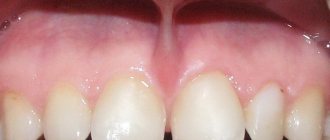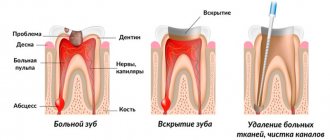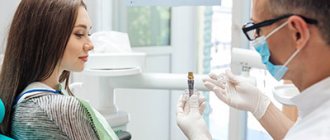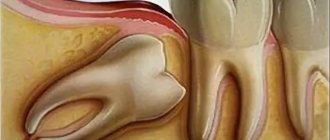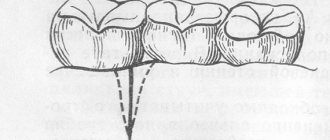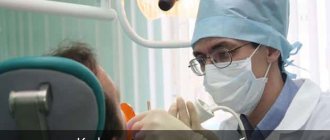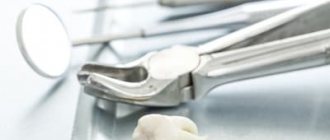After surgery, oral care requires special care and attention. The hardest part of the treatment is over, but for some time you still need to follow a number of rules that will protect your teeth and gums from new inflammations.
- After tooth extraction
- After frenuloplasty
- After implantation
Most often, special postoperative care is required during the postoperative period when installing dental implants. We will talk about it in more detail later, but for now we will list other, rarer, but also important cases when your teeth and gums require special care.
Indications
A short frenulum in the form of a longitudinal fold is located between the head and the movable flesh of the penis. Nerve fibers, blood vessels and lymph nodes are focused in this area, providing irritability to the organ.
The sensitivity of the frenulum is much higher than in the head of the penis, which increases excitability and brings orgasm closer. It acts as a natural regulator of a man’s erection, is responsible for tensioning the flesh during sexual intercourse, directs the bending of the head, and determines the displacement of the prepuce.
Most men are sure that the problem of organ performance in such a situation can be solved by circumcision of the foreskin, but doctors recommend this operation only in a hopeless situation.
A positive result is achieved by a simple surgical intervention - short frenuloplasty or frenulotomy. This is the name for dissection of the frenulum of the foreskin or, in some cases, removal of altered tissue resulting from scarring.
Plastic surgery frenulotomy is recommended for the following indications:
- changes and injuries of the genital organ;
- the occurrence of pain during sexual relations;
- bleeding as a result of mechanical damage;
- violation of the flesh of the head due to insufficient secretion (rupture, crack);
- uncontrolled ejaculation caused by the congenital structure of the short frenulum;
- incorrect positioning of the penis during arousal;
- prolonged feeling of discomfort in the head area (tension, tension);
- scarring of the skin at the site of ruptures;
- development of phimosis (narrowing of the foreskin opening).
During close contact, if pain occurs and bleeding develops, the person, trying to prevent a re-rupture, often restrains himself. Both physically and psychologically, this leads to difficulty completing orgasm. Against this background, an irreversible consequence develops - complete or partial erectile dysfunction. Therefore, if you notice any of the above symptoms, you should consult a doctor for advice.
Plastic surgery on the frenulum at the Miracle Doctor clinic
During the operation, the frenulum of the penis is lengthened using frenulotomy and dissection. First, a transverse incision is made, which is then sutured with a longitudinal cosmetic suture. The operation is performed under local anesthesia; anesthesia is not required.
The duration of frenulotomy is no more than 20 minutes. The recovery period takes 2 weeks, and after 21 days you can resume sexual activity. The longitudinal seam on the frenulum is a continuation of the natural seam of the penis, and therefore is practically invisible.
Contraindications
Frenulotomy of the short frenulum is considered a simple surgical operation. However, there are contraindications, which are diseases or inflammations occurring in the body:
- renal or liver failure;
- acute infectious diseases, inflammatory processes accompanied by fever;
- disturbances in the functioning of the genitourinary system;
- diseases associated with blood clotting disorders;
- scarring of the foreskin;
- organ oncology;
- sexually transmitted infections;
- complex diseases of the immune system (HIV);
- temporary decompensation.
Advantages of the technique
To eliminate problems with the function of the short frenulum, a surgical method is used. The size of the skin cord can only be changed through surgery. No folk remedies or conservative methods will bring positive results.
The frenulum lengthening procedure itself does not take long. Patients of all ages turn to doctors for help. As part of the preliminary preparation, appropriate tests and preparatory measures are required. These include:
- blood test to assess the general condition of the body;
- testing for the presence of diseases such as hepatitis, immunodeficiency, and sexually transmitted infections;
- Diagnostics of blood clotting.
It is important to take measures to stabilize blood pressure levels in order to prevent changes in indicators. In case of injury with heavy bleeding, blood supplies of a suitable type are needed.
Older men are at risk of developing hypokalemia (potassium deficiency). In this case, drugs containing potassium are prescribed.
At the preparatory stage for frenulotomy, the patient has no restrictions on food or liquid. It is recommended to strictly abstain from alcoholic beverages two to three days before surgery.
What care is required after tooth extraction
Tooth extraction may be indicated for various reasons. The main ones are excessive tooth decay due to caries and other oral diseases or tooth deformation after injury.
Basic rules after surgery
If you have had a tooth removed, special monitoring of your oral cavity is required in the first days after surgery. For the first few hours (usually the dentist determines the exact amount), it is not advisable to eat food or drink water. Avoid brushing the area where the tooth was removed with a toothbrush the first time you brush your teeth after surgery. For oral hygiene, use a brush with soft bristles. Do not use mouthwash. Follow this rule for two days.
When eating food over the next two days, exclude from your diet hard fruits, too hot or cold foods, as well as tea, coffee, alcohol and carbonated drinks. Smokers will have to give up their addiction, if not completely, then at least for two days after tooth extraction.
It often happens that after tooth extraction, the patient experiences swelling of the gums and swelling. There is no need to worry - this is a normal reaction of the gums after surgery. To reduce discomfort, place something fairly cold under your cheek on the side where the tooth was removed. Regular ice will do for this. Hold it on the sore spot for ten minutes, rest for twenty minutes and hold it again for ten minutes. The swelling will go down and will no longer bother you.
Increased physical activity is not recommended during the postoperative period. The fact is that active sports, lifting weights and strength exercises can cause bleeding at the extraction site. When you go to bed, place two pillows under your head at once - you need to keep your head elevated while sleeping.
Taking medications and the healing process
If you feel pain within a few days after tooth extraction, you can take painkillers, but only after the consent of the attending dentist. Analgesics are best for pain relief. If you, on the advice of your doctor, used antibiotics before surgery, then most likely your dentist will recommend that you stop using them gradually. You should not completely stop taking them right on the day of surgery; this can cause a decrease in the body's resistance and rapid proliferation of bacteria.
Finally, remember two particularly important recommendations to follow after surgery. If blood flows from the wound after tooth extraction, then place a tampon on this place, bite firmly and hold for forty-five minutes. Bleeding in itself is not a sign that something is wrong; it is a natural phenomenon, but it can cause a number of inconveniences. The only thing that should alert you is if the bleeding does not stop even after two procedures. Then contact your doctor immediately.
A blood clot should very quickly form in the empty socket at the site of the extracted tooth. It has a positive effect on the healing of the area. Be careful not to touch the clot. Not only is proper oral hygiene, which is described above, important, but it is also undesirable to spit so as not to injure the clot.
Algorithm for the frenulotomy procedure
- At the first stage, the skin of the patient’s inflamed area is carefully treated with a disinfectant.
- Then anesthesia is administered. During anesthesia, the age characteristics of the person are taken into account. For adolescents under 12 years of age, the drug is administered intravenously; for older patients, it is administered directly into the penis.
- When the anesthesia begins to take effect, the surgeon begins the operation. The frenulum is transversely dissected with a scalpel, a bandage (ligature) is applied to the sectional artery, then longitudinal sutures are applied to the resulting wound.
- If there is an old scar formed for one reason or another, it is removed immediately.
- At the end, apply a gauze bandage.
The frenulotomy procedure and the preparatory stage for it take only half an hour. After which the patient returns to daily activities, as hospitalization is not required.
In plastic surgery, there is another method of cutting the short frenulum - Y-Plasty. It differs in the way the cut is made. But she is not popular with doctors. When it is carried out, in addition to an unaesthetic incision, narrowing of the flesh is also possible, leading to physical complications. As a result of using this technique, there is a high risk of developing phimosis.
Short frenuloplasty: price
Price for plastic surgery of the frenulum of the foreskin (frenuloplasty, frenulotomy): 33 thousand rubles. The cost of tests is 2.5 thousand rubles. (you can not take it from us).
The price includes: the operation itself, anesthesia, preparation for the operation, stay in the ward, postoperative observation for 1.5 months. You don't need to pay anything else!
It is possible to perform frenuloplasty on the same day of treatment. In just 2-3 hours in the clinic you will get rid of the problem of a short frenulum forever!
Prevention
After the operation, the patient is recommended to follow preventive measures to prevent the development of inflammation resulting from infection at the operated site. These include compliance with the following recommendations of the attending physician:
- use of disinfectants to treat wounds;
- abstaining from sexual intercourse or masturbation until complete healing;
- maintaining personal hygiene, constant care of the genitals;
- refusal to visit a bathhouse or sauna, or an excessively hot bath.
Frenulotomy is performed in a network of clinics and centers located in Moscow and the Moscow region, the contacts of which are listed on our website. We offer a full range of services for patients of all ages: diagnostics, plastic procedures, postoperative care. There are qualified urologists, embryologists and other doctors specializing in this area.
Detailed information, address and opening hours are available on the clinics’ websites, where you can make an appointment for a preliminary examination and required treatment procedures.
Prices for frenulotomy vary between 5-10 thousand rubles. The cost depends on the scope of the examination, the complexity of the operation, as well as the qualifications of the doctor and the status of the hospital where the treatment is expected to be performed.
Reviews from men who have had frenulotomy are positive. In general, the majority note painlessness, rapid wound healing, elimination of the risk of scarring, a short rehabilitation period, and complete restoration of impaired penile functions.
Rehabilitation
A frenulum corrected by surgery heals within a fairly short period of time. The protective bandage can be removed after 12 hours; the stitches will take up to ten days to heal. If men experience pain after frenulotomy, doctors prescribe painkillers. During the rehabilitation period, special attention should be paid to personal hygiene:
- regular washing of the foreskin (2 times a day) with warm water;
- lubricating the operated area with moisturizing cream (E-45), which can be purchased at a pharmacy.
The complete healing process may take up to six weeks. Sexual relations can begin even 3-4 weeks after surgery. Highly qualified specialists from the Global Clinic Center will help eliminate male problems; they will monitor the patient from the first appointment to complete rehabilitation after surgery.
